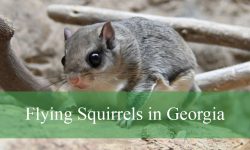Bugs in California are incredibly diverse, ranging from tiny insects to larger arthropods that you might encounter in gardens, homes, and wild areas. Understanding the common bugs found in this state can help you identify them easily and know how to react, especially if they bite or sting. This guide covers 30 of the most common bugs in California, complete with pictures and identification tips.
Many bugs in California play important roles in the environment, such as pollinating plants or controlling pest populations. However, some species can bite or sting, causing discomfort or allergic reactions. Knowing which bugs are common and how to recognize them is essential for safety and appreciation of California’s rich insect life.
This article provides clear information on the 30 common bugs in California. From mosquitoes and ants to spiders and wasps, each entry includes details to help you identify and understand these fascinating creatures found across the state.
Different Types of Bugs in California
Mosquito (Culex spp., Aedes spp.)
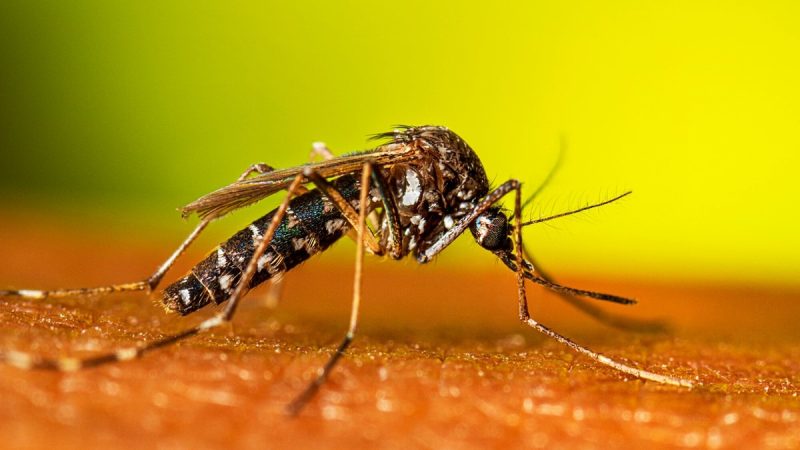
Mosquitoes are small flying insects known for their slender bodies, long legs, and distinctive wing scales. In California, the most common species belong to the genera Culex and Aedes. These mosquitoes vary in size from about 3 to 6 millimeters and are usually brownish or grayish in color. The females have specialized mouthparts for piercing skin and feeding on blood, which they need for egg production. Mosquitoes are active mostly during dawn and dusk, but some species can bite during the day.
Mosquitoes are not just a nuisance; they are also vectors for several diseases. In California, Culex mosquitoes can transmit West Nile virus to humans and animals, which can cause severe neurological symptoms in rare cases. Aedes species, like Aedes aegypti, are known carriers of dengue, Zika, and chikungunya viruses, although these diseases are less common in California. Their bites cause itchy red bumps that can become inflamed or infected if scratched excessively.
To reduce mosquito bites and the risk of disease, it is important to eliminate standing water where mosquitoes breed, such as birdbaths, clogged gutters, and flower pots. Using insect repellents containing DEET or picaridin and wearing long sleeves and pants during peak mosquito activity can also help prevent bites. Installing window and door screens and using mosquito nets outdoors provide additional protection.
Ants (Argentine, Fire, Harvester, etc.) (Linepithema humile, Solenopsis invicta)
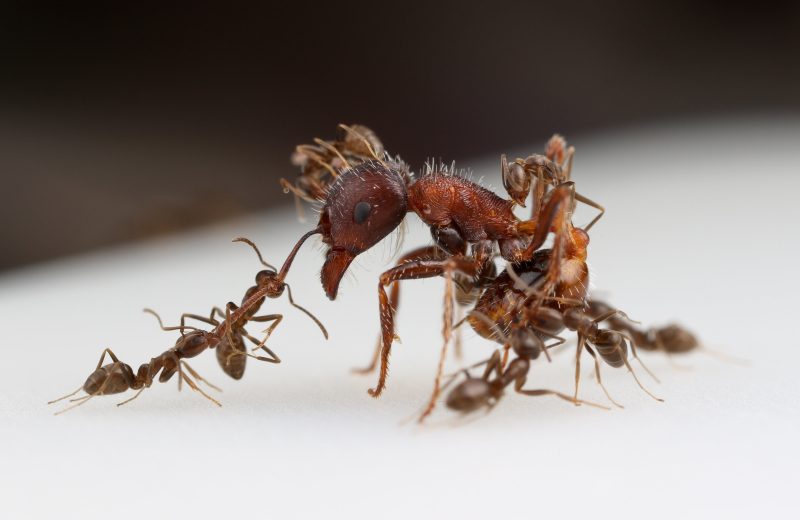
Ants are social insects that live in large colonies with complex social structures. The Argentine ant (Linepithema humile) is one of the most common invasive ant species in California, recognizable by its small size (about 2.2 to 2.8 mm), dark brown color, and fast-moving trails. Fire ants (Solenopsis invicta), although less widespread, are highly aggressive and known for their painful stings that can cause allergic reactions. Harvester ants (Pogonomyrmex spp.) are larger, reddish-brown ants that can deliver a powerful sting and are often found in dry, open habitats.
Among these species, fire ants pose the greatest health risk due to their venomous stings that cause burning sensations, swelling, and in some cases, severe allergic responses such as anaphylaxis. Argentine ants are more of a nuisance, invading homes and disrupting native ecosystems. Harvester ants can also sting, but their venom is generally less potent than that of fire ants. All three ants tend to forage in large groups and can contaminate food sources.
Preventing ant infestations involves sealing entry points in homes, keeping food in airtight containers, and maintaining cleanliness to reduce attractants. For fire ants and harvester ants, professional pest control may be necessary to safely remove nests. Avoid disturbing ant mounds and wear protective clothing when working outdoors in infested areas.
Yellowjacket Wasp (Vespula spp.)
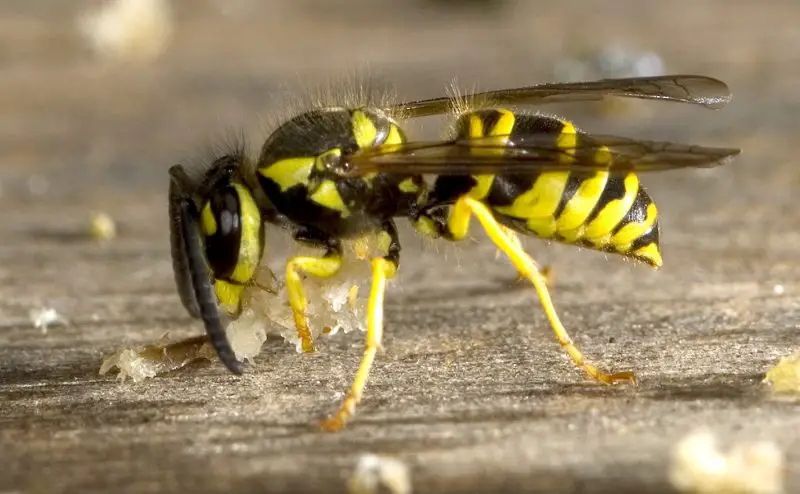
Yellowjackets are aggressive wasps identifiable by their bold black and yellow striped bodies, smooth slender waists, and sharp stingers. They measure about 12 to 17 millimeters in length and are common throughout California during late summer and early fall. Yellowjackets are social insects living in large underground or hidden nests, and they can sting multiple times, injecting venom that causes pain, swelling, and itching.
These wasps are notorious for their aggressive behavior, especially when defending their nests or attracted to food and sugary drinks at picnics. Their sting can cause painful reactions ranging from mild localized swelling to severe allergic reactions in sensitive individuals. Unlike bees, yellowjackets do not lose their stingers and can sting repeatedly, making them particularly dangerous if provoked.
To avoid yellowjacket stings, it is best to keep food and drinks covered when outdoors, avoid wearing strong perfumes or bright colors, and stay calm if one approaches. If a nest is spotted near your home, contacting pest control professionals is recommended for safe removal. Wearing protective clothing and avoiding sudden movements can reduce the chance of being stung.
Paper Wasp (Polistes spp.)

Paper wasps are slender, long-legged insects with reddish-brown bodies and yellow markings, measuring around 18 to 25 millimeters in length. They build distinctive open comb nests made of paper-like material, often hanging from eaves, branches, or porch ceilings. These wasps are less aggressive than yellowjackets but will defend their nests if threatened. Their stings can be painful and cause mild allergic reactions.
Paper wasps play an important role in ecosystems as predators of caterpillars and other garden pests, helping to control their populations naturally. They are generally not aggressive unless their nests are disturbed or they feel threatened. Their sting injects venom that causes localized pain, swelling, and redness, which usually subsides quickly unless an allergic reaction occurs.
To minimize encounters with paper wasps, avoid disturbing their nests and keep outdoor areas clean of food scraps. If a nest poses a risk, professional removal is recommended. Wearing long sleeves and pants while gardening and avoiding sudden movements near nests will reduce the likelihood of stings.
Fleas (Ctenocephalides felis)
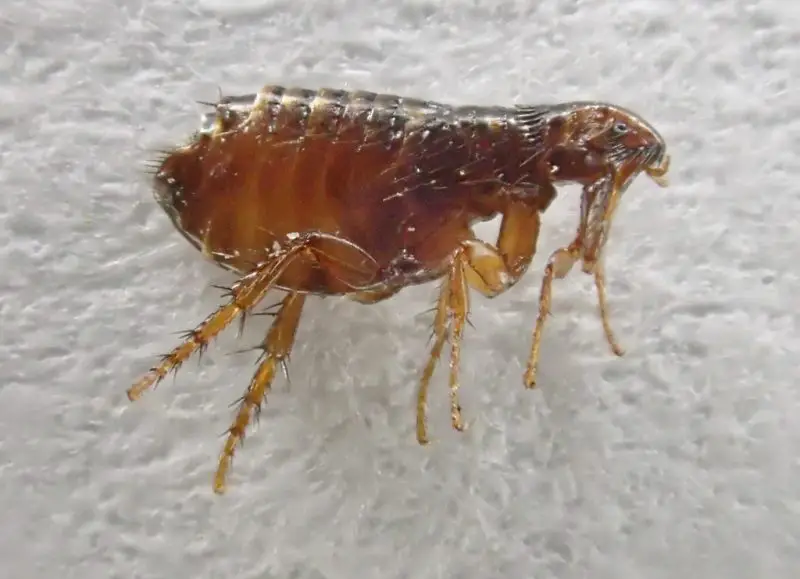
Fleas are tiny, wingless insects about 1.5 to 3.3 millimeters long, known for their ability to jump long distances relative to their size. The cat flea (Ctenocephalides felis) is the most common flea species in California, affecting pets like cats and dogs as well as humans. Fleas feed on blood by piercing the skin, causing itchy bites and skin irritation.
Flea bites often result in small, red, itchy bumps typically clustered around the ankles and legs in humans. Besides the discomfort, fleas can transmit diseases such as murine typhus and tapeworms to pets and occasionally humans. Heavy infestations on pets can lead to anemia, especially in young or weak animals.
Preventing flea infestations involves regularly treating pets with veterinarian-recommended flea control products, cleaning and vacuuming home environments, and washing pet bedding frequently. Avoiding contact with stray animals and maintaining outdoor areas can also reduce flea populations. If fleas are found in the home, professional pest control may be necessary for thorough eradication.
Spiders (Various House and Outdoor Spiders)
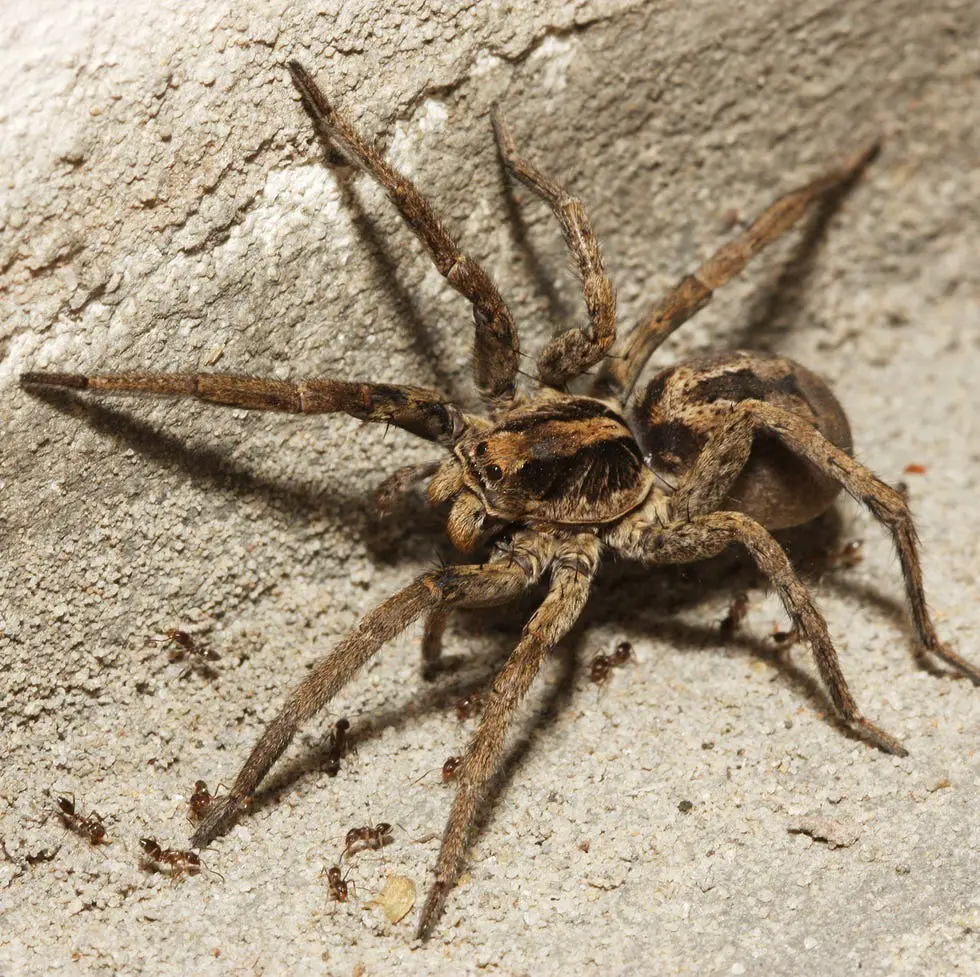
Spiders are arachnids commonly found in and around homes throughout California. They vary greatly in size and appearance, with many species having eight legs and multiple eyes. Most spiders are harmless to humans and play a beneficial role by controlling insect populations. Common house spiders build webs in corners, basements, or attics, while outdoor spiders may create orb webs or hunt without webs.
Though most spiders do not pose a threat, a few species like the black widow and brown recluse have venomous bites that can cause medical issues. Black widows have shiny black bodies with red hourglass markings, while brown recluses are tan with a violin-shaped mark on their backs. Their bites may cause pain, swelling, or more severe symptoms in sensitive individuals.
To avoid spider bites, keep your living spaces clean and clutter-free, seal cracks and openings, and reduce outdoor debris. Wearing gloves when handling firewood or gardening can prevent accidental encounters. If venomous spiders are suspected, seek professional pest control assistance for safe removal.
Bed Bugs (Cimex lectularius)

Bed bugs are small, reddish-brown insects about 4 to 5 millimeters long that feed exclusively on blood, mostly during the night. They hide in mattress seams, bed frames, furniture, and cracks near sleeping areas. Bed bug bites cause itchy, red welts often arranged in a line or cluster, and infestations can lead to sleep disturbances and anxiety.
While bed bugs do not transmit diseases, their bites can cause discomfort and secondary infections from scratching. They spread easily through luggage, secondhand furniture, and close contact with infested areas. Their flat bodies allow them to hide in tiny spaces, making detection and elimination challenging.
Preventing bed bug infestations involves inspecting hotel rooms while traveling, washing and drying bedding at high temperatures, and carefully checking secondhand items before bringing them inside. Professional pest control is usually necessary for effective eradication once an infestation occurs.
Ticks (Ixodes pacificus, Dermacentor spp.)
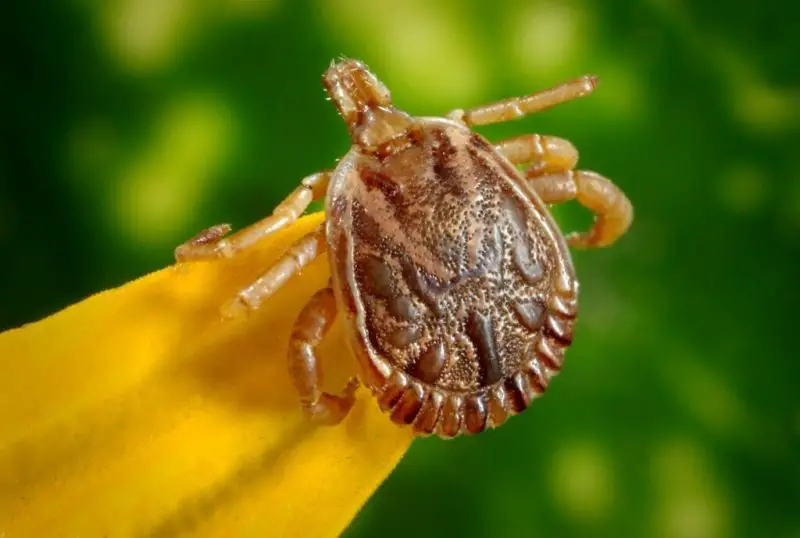
Ticks are small arachnids that feed on the blood of mammals, birds, and reptiles. In California, the western black-legged tick (Ixodes pacificus) and dog tick (Dermacentor spp.) are the most common species. Ticks vary in size, from tiny larvae less than 1 mm to adults around 3 to 5 mm. They typically attach to skin to feed and can transmit serious diseases like Lyme disease and Rocky Mountain spotted fever.
Ticks thrive in grassy, wooded, and brushy areas, making outdoor activities a risk for exposure. Their bites are often painless but can cause redness, itching, and sometimes a characteristic “bull’s-eye” rash with Lyme disease. Removing ticks promptly reduces the risk of disease transmission.
To protect against ticks, use insect repellents, wear long sleeves and pants tucked into socks when hiking, and perform thorough tick checks after outdoor activities. Keeping yards trimmed and removing leaf litter can reduce tick habitats near homes. If bitten, remove ticks carefully with tweezers and monitor for symptoms.
Horse Flies / Deer Flies (Tabanus spp., Chrysops spp.)
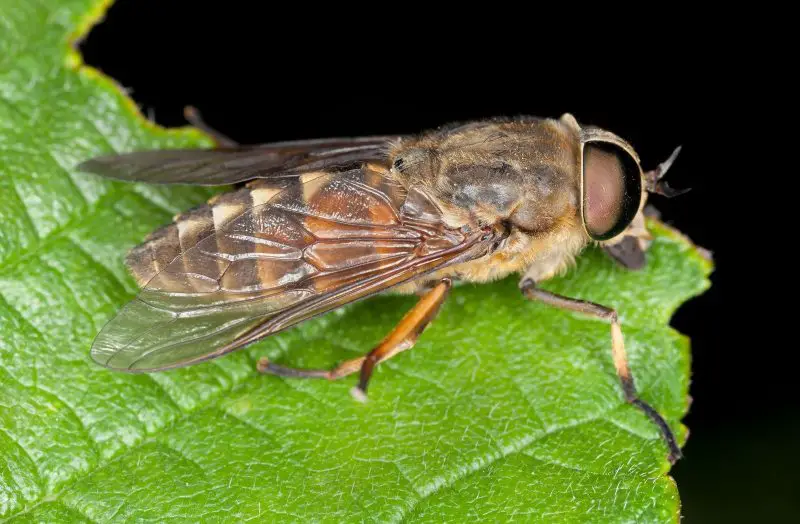
Horse flies and deer flies are large, fast-flying biting flies common in California’s rural and wetland areas. Horse flies (Tabanus spp.) are usually 10 to 25 millimeters long with robust bodies and large eyes, while deer flies (Chrysops spp.) are smaller and often have patterned wings. Both species bite painfully with sharp mouthparts that cut skin to feed on blood.
Their bites can cause intense pain, swelling, and itching, sometimes leading to allergic reactions or secondary infections. These flies are most active during warm, sunny days near water sources and livestock, making outdoor work and recreation uncomfortable during peak seasons.
To avoid bites, wear protective clothing with long sleeves and pants, use insect repellents effective against biting flies, and avoid areas with high fly activity during the hottest parts of the day. Fans or physical barriers like head nets can help reduce fly encounters. Prompt cleaning of bites reduces the risk of infection.
Biting Midges (No-see-ums) (Ceratopogonidae)
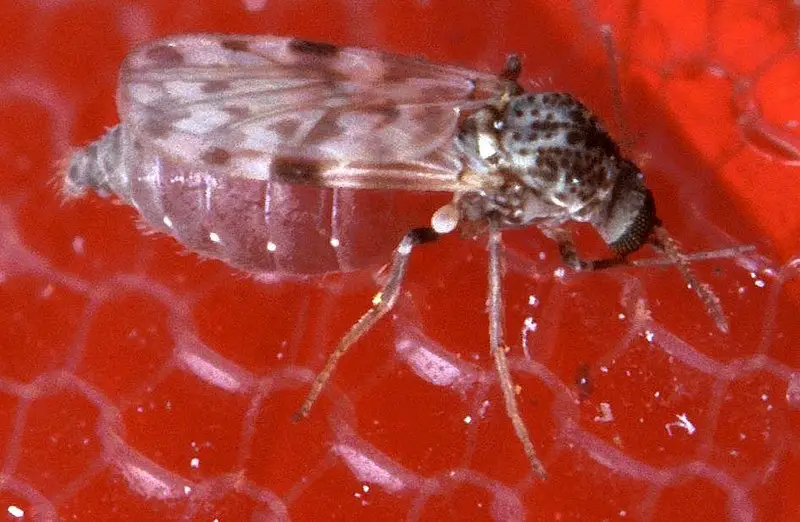
Biting midges, also known as no-see-ums, are tiny flying insects measuring only 1 to 3 millimeters. They are notorious for their painful bites despite their minuscule size and are common in California, especially near coastal and wetland areas. Their bites often cause small red bumps and intense itching.
These midges are most active during dawn and dusk and can penetrate thin clothing. Although they do not generally transmit diseases to humans, their bites can be very irritating and may cause allergic reactions in some people. They breed in moist soil and mud, making damp environments ideal for their populations.
Preventing bites involves using insect repellents containing DEET, wearing protective clothing, and avoiding outdoor exposure during peak activity times. Installing fine mesh screens on windows and doors can help keep midges out of homes. Reducing standing water and moist breeding sites around living areas also helps control their numbers.
Western Black Widow Spider (Latrodectus hesperus)
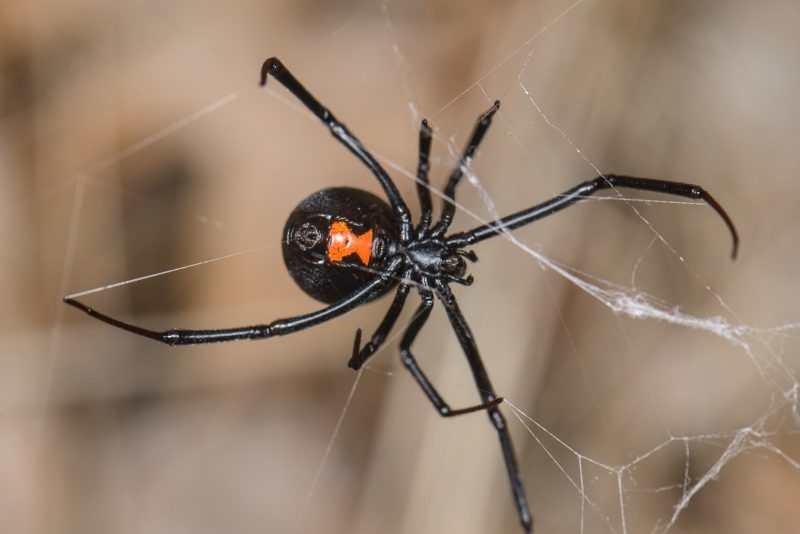
The Western Black Widow Spider is easily recognized by its shiny black body and distinctive red hourglass marking on the underside of its abdomen. Females are about 1.5 inches (including legs) and more venomous than males, which are smaller and less colorful. These spiders build irregular, tangled webs in dark, undisturbed places like woodpiles, garages, and sheds, often close to human habitation.
The venom of the Western Black Widow is neurotoxic and can cause severe muscle pain, cramps, and other systemic symptoms in humans, although bites are rarely fatal with medical treatment. They typically bite only in self-defense when accidentally disturbed or threatened. Bites may initially go unnoticed, but symptoms usually develop within hours.
To avoid bites, it is important to wear gloves when handling firewood or debris and to be cautious in areas where these spiders live. Keeping storage areas tidy and sealing cracks around buildings can reduce encounters. If bitten, seeking immediate medical attention is crucial, especially for children or those with health conditions.
Velvet Ant (Cow Killer Ant) (Dasymutilla spp.)
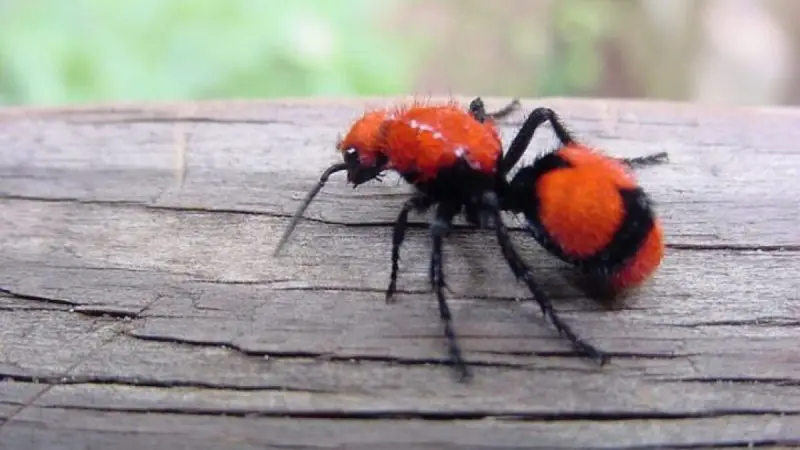
Velvet ants are actually wasps with bright, hairy bodies that often look like large, colorful ants. The “cow killer” nickname comes from the intense, painful sting they deliver, which can feel like a strong bee or wasp sting. They range in size from about 10 to 20 millimeters and have red, orange, or yellow hair covering their bodies, making them easy to spot in California’s dry, sandy environments.
These insects are solitary and do not build nests; females roam searching for ground-nesting bees or wasps to parasitize by laying their eggs inside the host’s nest. Their sting is painful but not dangerous to humans unless allergic reactions occur. They are generally not aggressive and sting only when handled or provoked.
Avoiding velvet ants involves staying clear of areas with sandy soil and wildflowers where they are likely to be active. Wearing protective clothing while hiking and refraining from touching unfamiliar insects can prevent painful encounters. Despite their painful sting, velvet ants play an important role in controlling other insect populations.
Western Corsair (Assassin Bug) (Rasahus thoracicus)
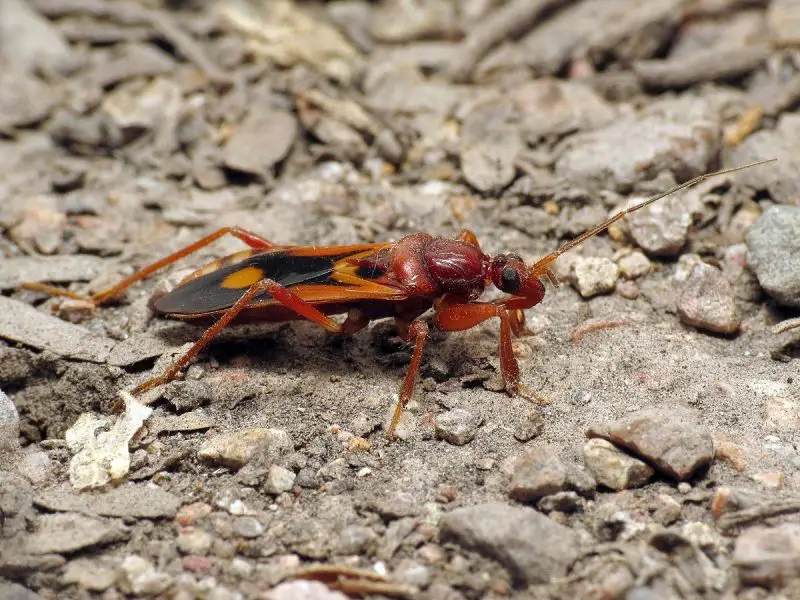
The Western Corsair is a large, predatory insect known for its elongated body, dark coloration with reddish or orange markings, and long legs. It measures about 25 to 35 millimeters in length and uses its sharp, curved proboscis to inject venom into prey such as other insects and small arthropods. Found in California’s chaparral, woodlands, and gardens, the Western Corsair is an effective natural pest controller.
Though primarily a predator of insects, the Western Corsair can deliver a painful “bite” to humans if handled carelessly. Its bite can cause localized pain, swelling, and numbness but is not medically serious. The insect is mostly active at night and hides under bark or leaf litter during the day.
Preventing bites includes avoiding handling this bug and wearing gloves when gardening or working in natural areas. Appreciating their role as pest controllers can help reduce unnecessary fears. Their presence often indicates a healthy and balanced ecosystem.
Red Imported Fire Ant (Solenopsis invicta) – localized, invasive
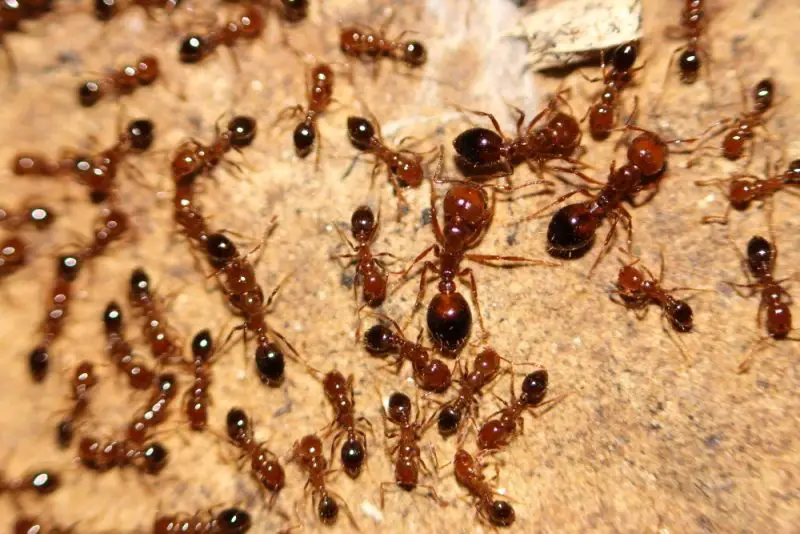
The Red Imported Fire Ant is a notorious invasive species with reddish bodies and darker abdomens, measuring about 2.4 to 6 millimeters in length. Originally from South America, it has established localized populations in California. These ants build large, mound-shaped nests often in lawns, parks, and disturbed soils, aggressively defending their colonies with painful stings.
Their venom causes a burning sensation followed by itchy pustules that can lead to infections or allergic reactions. Fire ants can sting repeatedly and are known for their aggressive swarming behavior when disturbed. Their invasive nature disrupts local ecosystems by displacing native ants and harming wildlife.
Controlling Red Imported Fire Ants requires professional pest management as they are difficult to eradicate. Homeowners should avoid disturbing nests and keep yards well-maintained to reduce habitat. Awareness and early detection are key to preventing their spread in California.
Giant Water Bug (Lethocerus spp.)
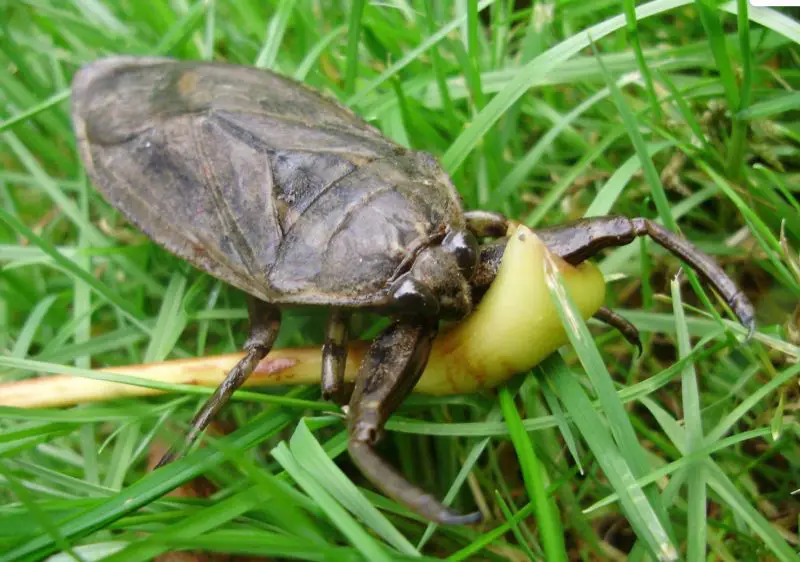
Giant Water Bugs are large aquatic insects sometimes called “toe-biters” due to their painful bite. They can grow up to 12 centimeters long and have flat, oval bodies with strong front legs adapted for catching prey. Found in freshwater ponds, lakes, and slow-moving streams in California, these insects are excellent swimmers and predators of fish, amphibians, and other aquatic insects.
Though not aggressive toward humans, Giant Water Bugs can deliver a painful bite if handled or provoked, injecting digestive enzymes that cause intense localized pain and swelling. They are nocturnal hunters and use their powerful front legs to grasp prey before piercing it with their beak-like mouthparts.
Avoid handling these bugs and wear protective gloves when working near water bodies. Their presence indicates healthy aquatic ecosystems, and they play an important role in controlling populations of aquatic pests. Despite their intimidating size and bite, they pose little threat to humans if left undisturbed.
Wheel Bug (Arilus cristatus)

The Wheel Bug is one of the largest true bugs in California, measuring about 25 to 45 millimeters in length. It is easily identified by the distinctive cogwheel-shaped “crest” on its thorax, which resembles a saw blade. These predatory insects are mostly gray or brown and have strong forelegs used to catch and hold prey, feeding primarily on other insects such as caterpillars and beetles.
Wheel Bugs are beneficial to gardens as natural pest controllers but can deliver a very painful bite if handled or threatened. The bite injects enzymes that cause intense localized pain, swelling, and sometimes numbness, though it is not medically serious. They are generally shy and avoid human contact.
To prevent bites, avoid handling them directly and wear gloves when gardening in areas where Wheel Bugs are common. Appreciating their role in controlling pest insects can help gardeners encourage their presence without fear. Their unique appearance makes them a fascinating insect to observe from a safe distance.
Backswimmer (Notonecta spp.)
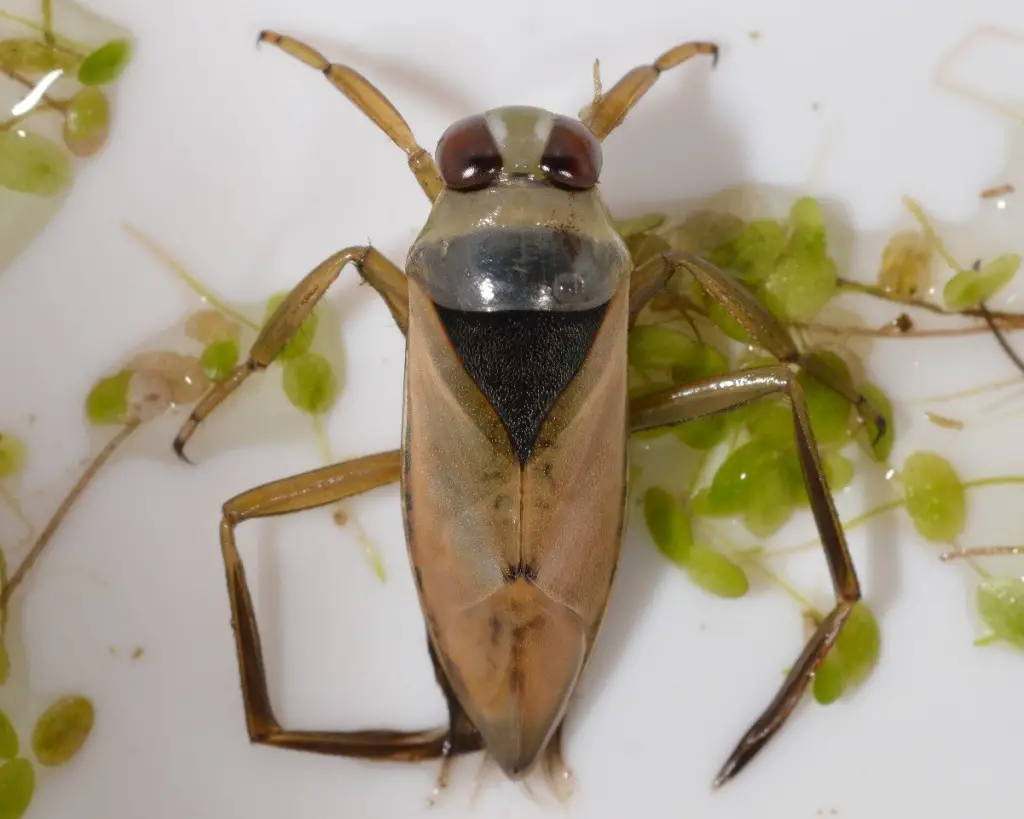
Backswimmers are aquatic insects commonly found in ponds, lakes, and slow streams across California. Measuring about 12 to 15 millimeters long, they are named for their habit of swimming upside down near the water surface. Their streamlined bodies are typically brown or greenish, with long hind legs fringed with hairs that act like oars for swimming.
These insects are aggressive predators feeding on other aquatic insects, tadpoles, and small fish. They use their sharp mouthparts to stab and inject digestive enzymes into prey. Although not usually aggressive toward humans, backswimmers can deliver a painful bite if handled or caught, causing localized swelling and discomfort.
To avoid bites, refrain from handling backswimmers, especially with bare hands. Using nets to observe or remove them is safer. They play an important role in aquatic ecosystems by controlling insect populations and are indicators of healthy freshwater habitats.
Water Scorpion (Ranatra spp.)

Water Scorpions are slender aquatic insects that resemble walking sticks with long front legs adapted for grabbing prey. They measure about 30 to 45 millimeters in length and have a long breathing tube extending from the end of their abdomen, allowing them to breathe while submerged. Found in still or slow-moving waters throughout California, they blend well with aquatic vegetation.
They are ambush predators feeding on small fish, tadpoles, and aquatic insects. Water Scorpions use their front legs to capture prey and then inject enzymes to immobilize and digest it. While they are not aggressive toward humans, they can give a painful bite if mishandled.
Avoid direct contact by observing these insects with nets or from a distance. Maintaining healthy aquatic habitats supports their populations, which help balance ecosystems by controlling prey species. Their unique body shape and stealthy hunting behavior make them interesting creatures in freshwater environments.
Thrips (Thysanoptera)

Thrips are tiny, slender insects measuring only 1 to 2 millimeters long, often barely visible to the naked eye. They have fringed wings and feed primarily on plants by piercing and sucking the contents of plant cells. Thrips are common pests in gardens, greenhouses, and agricultural fields across California, affecting flowers, fruits, and vegetables.
Though small, thrips can cause significant damage by creating silvery or stippled discolorations on leaves, deforming flowers, and transmitting plant viruses. They reproduce rapidly, which makes infestations difficult to control. Thrips do not bite humans but may cause mild skin irritation in rare cases.
Preventing thrips involves maintaining plant health, using insecticidal soaps or neem oil, and encouraging natural predators like ladybugs and lacewings. Monitoring plants regularly helps detect infestations early. Integrated pest management strategies provide the best control while minimizing harm to beneficial insects.
Saucer Bug (Belostomatidae, smaller water bugs)

Saucer Bugs are smaller relatives of giant water bugs, belonging to the Belostomatidae family. They typically measure around 15 to 30 millimeters and inhabit freshwater ponds and slow streams in California. These insects have flattened, oval bodies and strong, raptorial front legs designed for grasping prey.
Like their larger cousins, Saucer Bugs are aquatic predators feeding on insects, tadpoles, and small fish. They use their sharp beaks to inject digestive enzymes and suck out fluids from their prey. While generally not aggressive toward humans, they can deliver a painful bite if handled or disturbed.
To avoid bites, observe Saucer Bugs from a distance and avoid direct contact. Their presence indicates healthy aquatic environments, and they contribute to controlling populations of other small aquatic organisms. Saucer Bugs are important members of freshwater ecosystems and an interesting subject for insect enthusiasts.
Kissing Bug (Conenose Bug) (Triatoma protracta)

The Kissing Bug, also known as the Conenose Bug, is a large, dark-colored insect with a flattened, elongated body measuring about 15 to 25 millimeters. It has distinctive orange or red markings along the edges of its body and long, thin legs. Found in California’s arid and semi-arid regions, this nocturnal insect often hides in cracks and crevices near human dwellings or animal shelters.
Kissing Bugs are blood-feeders, primarily on mammals including humans, and get their name from their tendency to bite near the mouth or eyes during sleep. While their bite can cause localized swelling and irritation, they are best known as potential vectors of Chagas disease, though the risk in California is very low. They usually bite at night and are attracted by body heat and carbon dioxide.
To avoid bites, seal gaps in homes and avoid sleeping outdoors without protection in infested areas. Using screens and bed nets can reduce encounters. If bitten, cleaning the wound and monitoring for infection is important. Despite their intimidating name, Kissing Bugs are generally shy and bite only when disturbed.
Centipede (Scolopendra polymorpha)
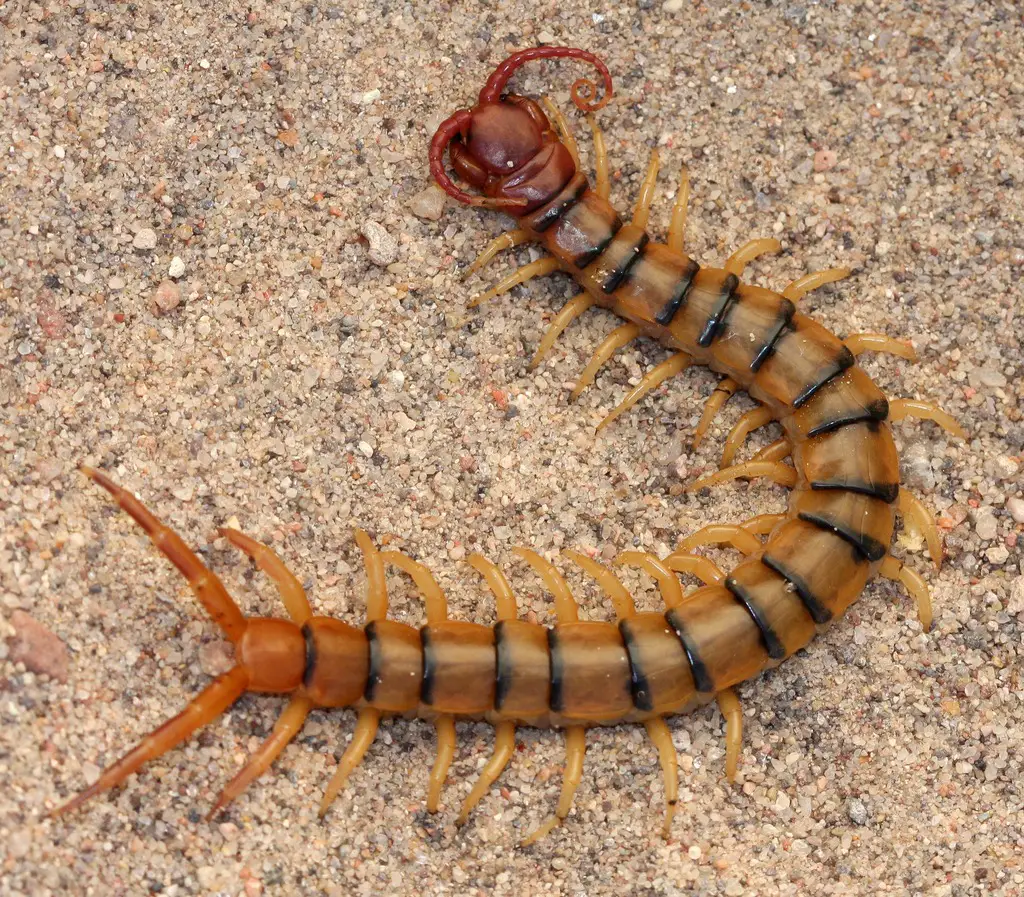
The Centipede Scolopendra polymorpha, commonly called the Desert Centipede, is a large, fast-moving arthropod with a segmented body and many legs, typically reddish-brown or yellowish in color. It can grow up to 15 centimeters long and is known for its agility and predatory habits. These centipedes inhabit deserts and dry areas throughout California, hiding under rocks and debris during the day.
Centipedes use venomous claws located near their head to capture and subdue prey such as insects, spiders, and small lizards. Their bite is painful and can cause swelling, redness, and localized numbness but is rarely dangerous to humans unless allergic reactions occur. They are mostly nocturnal hunters and avoid human contact.
To prevent centipede encounters, keep living areas clean and free of clutter where they can hide. Sealing cracks and removing debris outside your home can reduce their presence. Wearing gloves when handling firewood or rocks helps avoid painful bites. Centipedes are important predators that help control insect populations.
Scorpion (Paruroctonus spp., Vaejovis spp.)
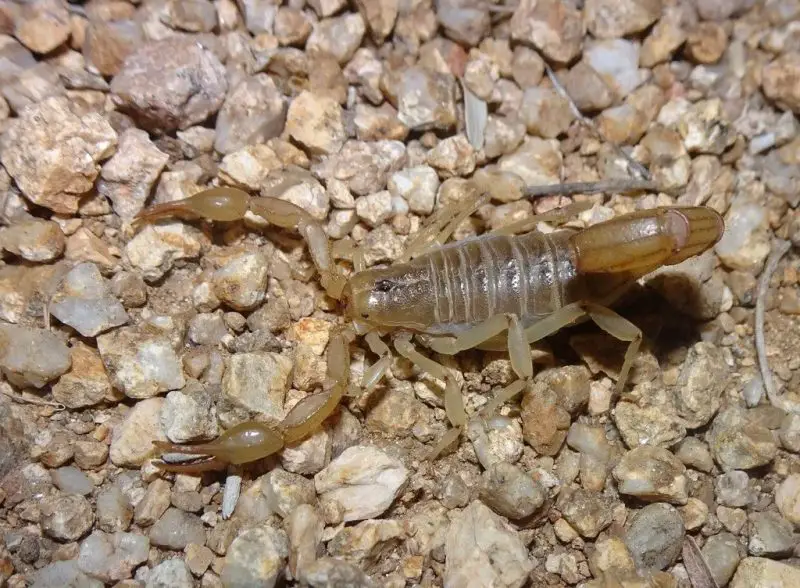
Scorpions in California, particularly species like Paruroctonus and Vaejovis, are small to medium-sized arachnids, typically 3 to 7 centimeters long with a segmented tail ending in a venomous stinger. They are usually light brown or tan, blending well with desert and scrub habitats. Scorpions are nocturnal and spend the day hiding under rocks, logs, or in crevices.
Their sting delivers venom that can cause sharp pain, swelling, and numbness. Although their venom is usually not life-threatening to healthy adults, children and allergic individuals should seek medical attention if stung. Scorpions use their sting to capture prey such as insects and spiders and to defend themselves.
Avoiding scorpion stings involves wearing boots and gloves when outdoors, shaking out shoes and clothing before use, and sealing entry points in homes. Scorpions play an important role in controlling insect populations and are generally not aggressive unless provoked.
Brown Widow Spider (Latrodectus geometricus)

The Brown Widow Spider is a close relative of the infamous Black Widow but is typically lighter in color, ranging from tan to dark brown with irregular patterns on its body. It is slightly smaller than the Black Widow, with females about 1.5 centimeters long. This species is common in California and builds messy webs in sheltered areas like under eaves, fences, and outdoor furniture.
Brown Widow venom is less potent than that of the Black Widow but can still cause painful bites with symptoms such as muscle cramps, nausea, and localized pain. Bites are rare and typically occur when the spider is accidentally disturbed or trapped against skin. They are less aggressive and tend to flee when threatened.
To minimize bites, keep areas around buildings clean and free of clutter where spiders might hide. Wear gloves when working in storage or outdoor areas and shake out clothing and shoes before use. Brown Widows are beneficial in controlling insect pests despite their venomous bite.
Yellow Sac Spider (Cheiracanthium spp.)
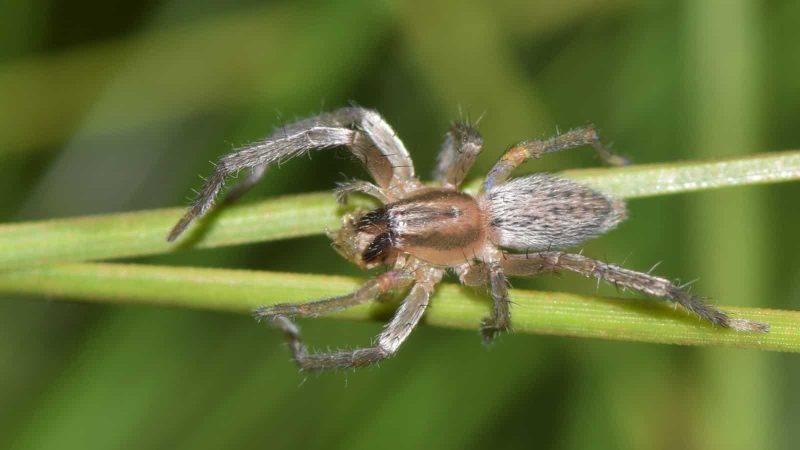
Yellow Sac Spiders are small, pale yellow or light green spiders measuring about 5 to 10 millimeters long. They are commonly found in homes and gardens across California, often building small silk sacs or retreats in corners, under leaves, or inside rolled leaves during the day. These spiders are active hunters at night, preying on small insects.
Their bite can cause mild to moderate pain and localized swelling, sometimes resulting in skin irritation or a small ulcer. Although rarely dangerous, some bites may cause symptoms that last several days. Yellow Sac Spiders are not aggressive and usually bite only when trapped against the skin.
Preventing bites involves reducing clutter inside homes, sealing cracks, and shaking out bedding or clothing. Wearing gloves when gardening or handling plant material can also help avoid accidental bites. These spiders help reduce pest insect populations and are generally beneficial despite their occasional bites.
Caterpillars with Stinging Hairs (Saddleback, Io moth, etc.)
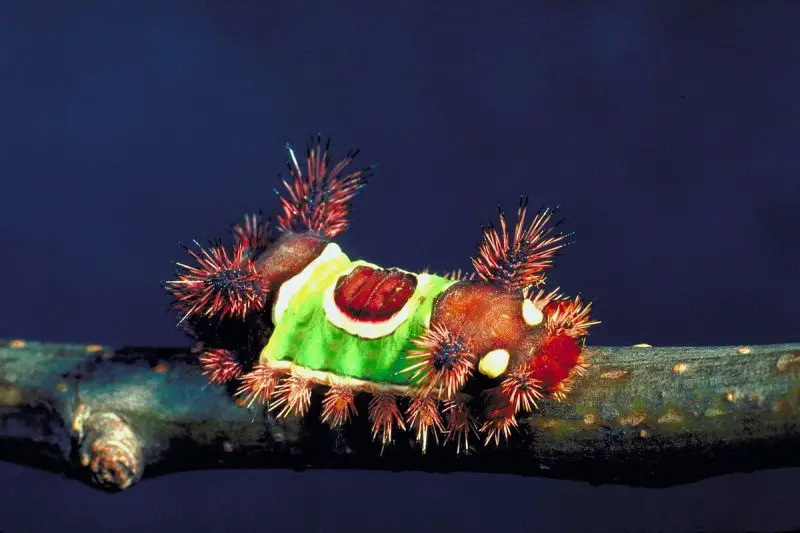
Caterpillars with stinging hairs, such as the Saddleback and Io moth caterpillars, are known for their brightly colored bodies covered in tiny venomous spines. These spines can deliver painful stings causing itching, swelling, and sometimes rash when touched. They are typically found on trees, shrubs, and plants across California during their larval stages.
These caterpillars feed on leaves and can sometimes cause noticeable defoliation in gardens and forests. The Saddleback caterpillar is easy to identify by its distinctive green “saddle” marking bordered with white and brown, while the Io moth caterpillar is bright green with long stinging spines and orange spots. Despite their painful defense, they eventually transform into harmless moths.
Avoid handling these caterpillars with bare hands and teach children to recognize and steer clear of them. Wearing gloves when gardening and inspecting plants carefully can help prevent stings. These caterpillars are part of the natural ecosystem, contributing to the food web despite their painful defense mechanisms.
Harvester Ant (Pogonomyrmex spp.)
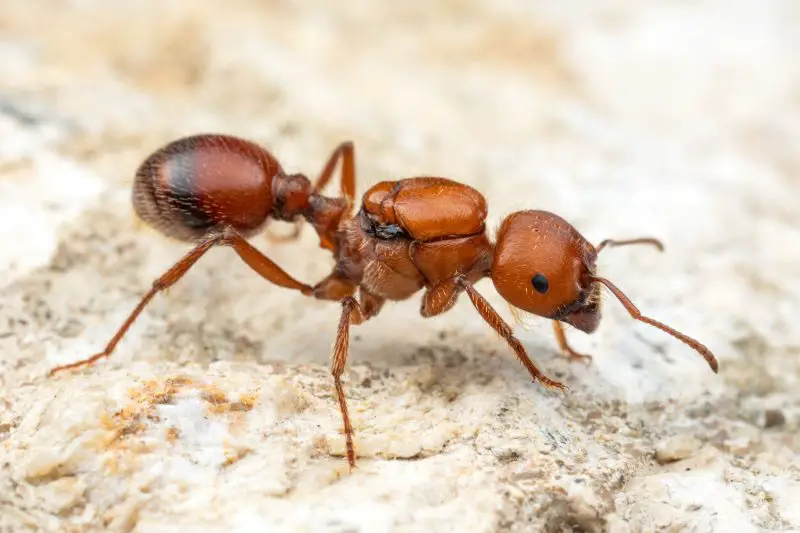
Harvester ants are medium-sized reddish or brown ants commonly found in dry, sandy soils throughout California. They build large nests marked by cleared areas of bare soil and are known for their aggressive behavior and painful stings. These ants are active during the day and forage on seeds, insects, and plant material.
Their sting injects venom that causes a burning sensation and swelling; multiple stings can be very painful, especially for allergic individuals. Harvester ants defend their nests vigorously, biting and stinging intruders. They play an important role in seed dispersal and soil aeration.
To avoid stings, watch for harvester ant mounds and avoid stepping on them. Wear closed shoes and avoid disturbing nests. If stung, cleaning the area and applying ice can help reduce pain and swelling. Harvester ants are an essential part of California’s arid ecosystem despite their defensive nature.
Assassin Bug (general group) (Reduviidae)
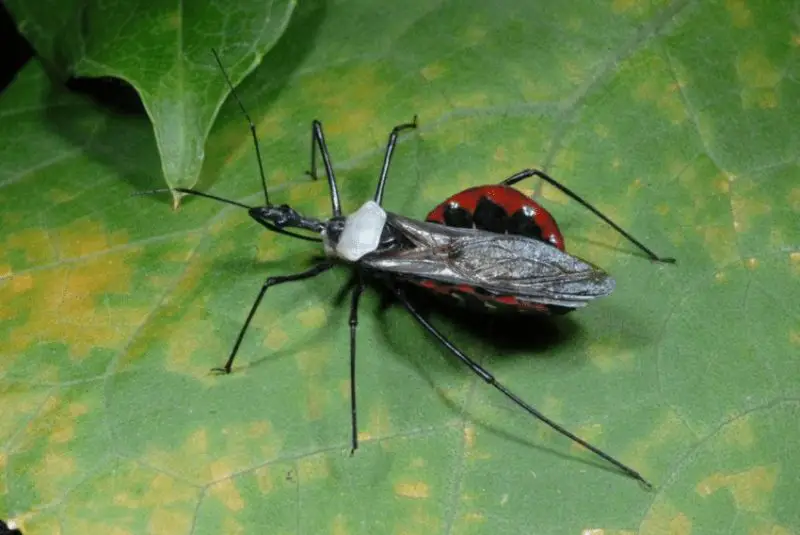
Assassin bugs are a diverse group of predatory insects known for their elongated bodies and powerful piercing mouthparts. They hunt other insects by stabbing them and injecting digestive enzymes that liquefy their prey’s insides. Assassin bugs are found in gardens, forests, and grasslands throughout California.
While beneficial for pest control, some assassin bugs can deliver a painful bite if handled or threatened. The bite can cause localized swelling, redness, and discomfort but is not generally dangerous to humans. Assassin bugs vary in size and coloration, often camouflaged to blend with their surroundings.
Avoid handling these insects with bare hands and use caution when gardening or exploring natural areas. Assassin bugs help keep insect populations in check and contribute to ecological balance. Observing them from a distance reveals fascinating predatory behaviors.
Blow Fly / Botfly Larvae (Calliphoridae, Cuterebra spp. – rare but harmful)
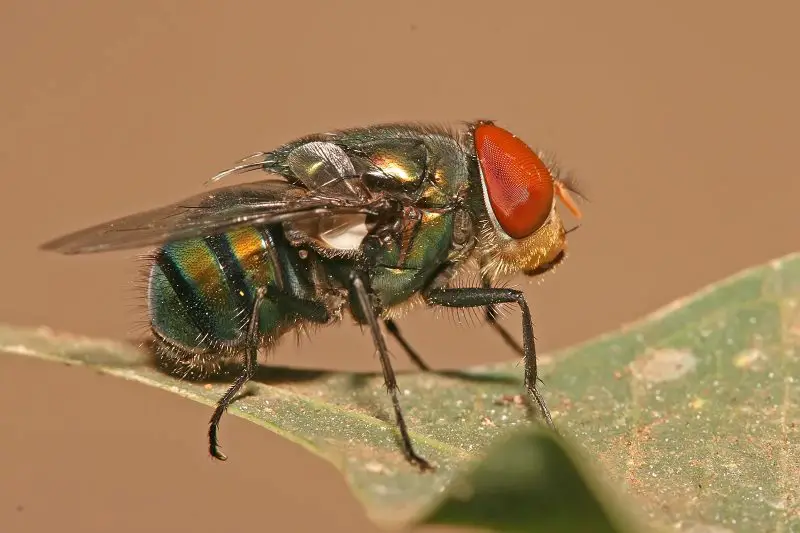
Blow flies are metallic-looking flies often seen around decaying organic matter. Some species in California are important decomposers, but their larvae can occasionally cause health issues. Botfly larvae, which are parasites of mammals, are rare but can infest pets or wildlife by developing under the skin.
The larvae cause painful swellings and may lead to infections if untreated. Blow fly larvae feed on dead tissue, while botfly larvae develop inside living hosts, causing myiasis. Although human infestation is rare, these flies pose risks to pets and livestock in certain areas.
Preventive measures include good sanitation, protecting pets with insect repellents, and maintaining clean environments. Veterinary care is needed to remove botfly larvae. Awareness helps reduce risks while appreciating the ecological role of blow flies in decomposition.
Western Bumble Bee (Bombus occidentalis) – rarely stings, but possible
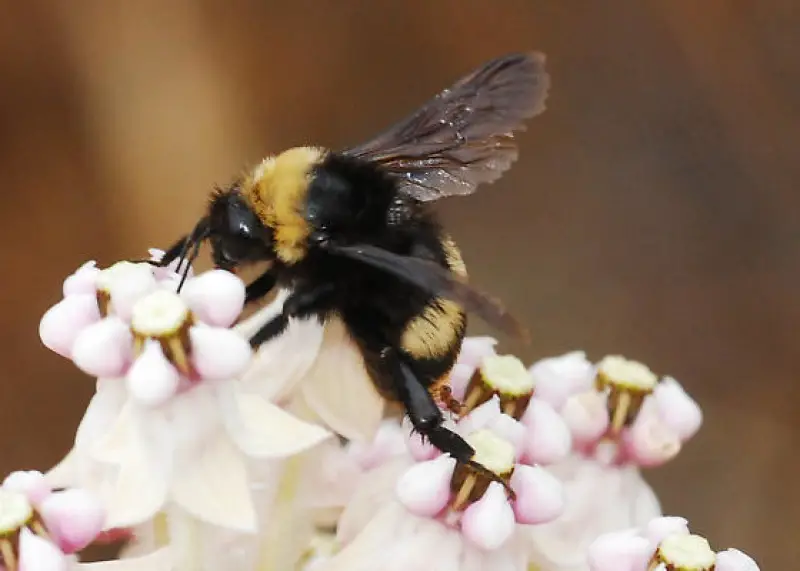
The Western Bumble Bee is a large, fuzzy bee native to California, characterized by its black and yellow bands. These social bees play a crucial role in pollinating wild plants and crops. They are generally non-aggressive and sting only when directly threatened or provoked.
Their sting can cause mild to moderate pain, similar to a wasp sting, and allergic reactions are rare but possible. Western Bumble Bees prefer open fields, gardens, and meadows where flowers are abundant. Their presence is a positive indicator of healthy ecosystems.
To avoid stings, observe these bees without disturbing their nests and avoid sudden movements. Wearing light-colored clothing and avoiding strong scents can reduce encounters. Supporting bumble bee habitats benefits pollination and biodiversity.


